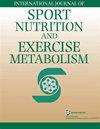使用生物电阻抗分析替代双能x射线吸收法计算女性青少年运动员能量利用率的无脂质量。
IF 3
3区 医学
Q2 NUTRITION & DIETETICS
International journal of sport nutrition and exercise metabolism
Pub Date : 2022-05-06
DOI:10.1123/ijsnem.2021-0301
引用次数: 1
摘要
能量可用性(EA)是通过从能量摄入中减去运动能量消耗来计算的,并根据使用精确方法(如双能x射线吸收仪(DXA))获得的无脂质量(FFM)进行调整。与DXA不同,生物电阻抗分析(BIA)成本低,操作简单,易于实施。本研究旨在检验通过社交媒体招募的女青少年运动员(n = 94)使用四个BIA预测方程的FFM值计算EA与使用DXA获得的FFM之间的一致性。采用配对Student’st检验、Wilcoxon检验、Lin’s一致性相关系数、均方根误差、一致性限和平均绝对百分比误差来评价4个SF-BIA预测方程得到的FFM值与DXA的一致性。采用回归线性分析确定DXA获得的FFM值与BIA预测方程之间的关系。以DXA值为参考,计算FFM和EA的标准化残差。以性成熟为变量的方程最适合FFM(一致性限= 4.0/-2.6 kg,均方根误差= 1.9 kg,平均绝对百分比误差= 4.34%,Lin’s一致性相关系数= 0.926)和EA(一致性限= 2.51/4.4 kcal·kg FFM-1·day-1,均方根误差= 1.8 kcal·kg FFM-1·day-1,平均绝对百分比误差4.24%,Lin’s一致性相关系数= 0.992)。而年龄变异性最大的方程是一致性最低的方程。FFM-BIA预测方程可用于计算女青少年运动员的EA。然而,选择这个等式时应该考虑到性别、年龄和成熟状态。在运动员的情况下,研究人员应该使用为这一群体开发的方程。本文章由计算机程序翻译,如有差异,请以英文原文为准。
Fat-Free Mass Using Bioelectrical Impedance Analysis as an Alternative to Dual-Energy X-Ray Absorptiometry in Calculating Energy Availability in Female Adolescent Athletes.
Energy availability (EA) is calculated by subtracting exercise energy expenditure from energy intake, adjusted for fat-free mass (FFM) obtained using accurate methods, such as dual-energy X-ray absorptiometry (DXA). Unlike DXA, the bioelectrical impedance analysis (BIA) is low in cost, simple and easy to carry out. This study aimed to test the concordance between the calculation of EA using FFM values from four BIA predictive equations and FFM obtained using DXA in female adolescent athletes (n = 94), recruited via social media. Paired Student's t test, Wilcoxon test, Lin's concordance correlation coefficient, root mean square error, limits of agreement, and mean absolute percentage error were used to evaluate agreement between the FFM values obtained by the four SF-BIA predictive equations and DXA. Regression linear analysis was used to determine the relation between FFM values obtained using DXA and the BIA predictive equations. Standardized residuals of the FFM and EA were calculated considering DXA values as reference. The most appropriate model for the FFM (limits of agreement = 4.0/-2.6 kg, root mean square error = 1.9 kg, mean absolute percentage error = 4.34%, Lin's concordance correlation coefficient = .926) and EA (limits of agreement = 2.51/4.4 kcal·kg FFM-1·day-1, root mean square error = 1.8 kcal·kg FFM-1·day-1, mean absolute percentage error 4.24%, Lin's concordance correlation coefficient = .992) was the equation with sexual maturity as a variable, while the equation with the greatest age variability was the one with the lowest agreement. FFM-BIA predictive equations can be used to calculate EA of female adolescent athletes. However, the equation should be chosen considering sex, age, and maturation status. In the case of athletes, researchers should use equations developed for this group.
求助全文
通过发布文献求助,成功后即可免费获取论文全文。
去求助
来源期刊
CiteScore
5.00
自引率
8.00%
发文量
50
审稿时长
6-12 weeks
期刊介绍:
The International Journal of Sport Nutrition and Exercise Metabolism (IJSNEM) publishes original scientific investigations and scholarly reviews offering new insights into sport nutrition and exercise metabolism, as well as articles focusing on the application of the principles of biochemistry, physiology, and nutrition to sport and exercise. The journal also offers editorials, digests of related articles from other fields, research notes, and reviews of books, videos, and other media releases.
To subscribe to either the print or e-version of IJSNEM, press the Subscribe or Renew button at the top of your screen.

 求助内容:
求助内容: 应助结果提醒方式:
应助结果提醒方式:


